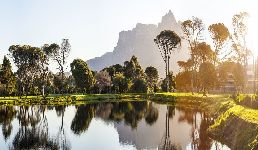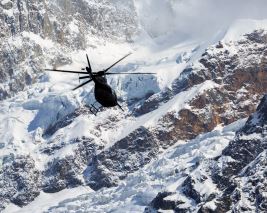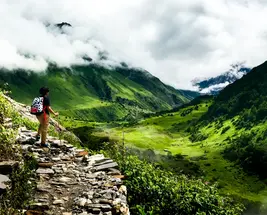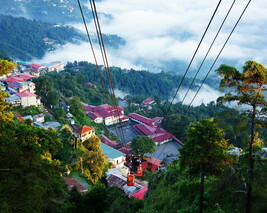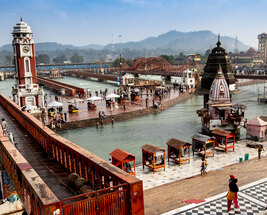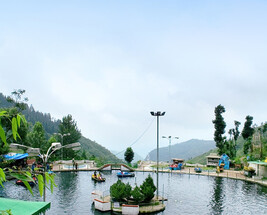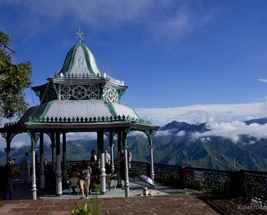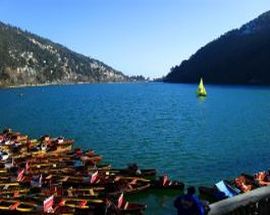Bali Pass Trek
An Offbeat Path to Explore the Himalayas and Expand Your Trekking Abilities!
Bali Pass is a mystical place settled in the lap of the mighty Himalayas and extends an invitation to anyone who seeks a thrill away from bustling city life.
Information about the Bali Pass Trek
From silvering snow fields to uninhabited villages, Bali Pass has several attractions hidden in layers. You can take a dip in holy waters, seek divine blessings, find photo opportunities at every step, and camp under a starry night sky—all within a week!
Location
Bali Pass sits at an elevation of 16240 ft and is nestled in the Govind Ballabh Pant Wildlife Sanctuary in the Uttarkashi district of Garhwal, Uttarakhand.
Trek Guide
- Be well-informed about the trek. Read about the experience of other trekkers who have already been there. Read Bali Pass trek blogs to learn more about the same.
- Carry mandatory legal documents such as ID proof, medical certificate, passport-sized photograph, etc.
- Pack a personal medical kit in your backpack. Make sure to add paracetamol, Avomine, Digene, Dolo 65, etc.
Places to visit in Bali Pass
Yamunotri Temple
Yamunotri Temple is one of India's four Chota Char Dham pilgrimage sites dedicated to Goddess Yamuna. You shouldn't miss taking a dip in the resplendent springs of Gouri and Surya Kund.
Gangad and Osla Villages
Brimming with old temples, interesting Himalayan folklore, and lush green meadows, these ancient villages will take you back in time and are covered under the Bali Pass trek cost.
Ruinsara Lake
It is a serene glacial lake that boasts tranquillity in every sense and is still untouched by commercialisation. So, you can soak in some peaceful vibes while gazing at the panoramic views.
Activities to do in Bali Pass
Stargazing
If you are a fan of stargazing, make sure to carry your own telescope to witness the stars and galaxies from Bali Pass.
Camping
Bali Pass is a hot spot for campsites like Dev Thatch, Untigad, and Damini Forest. Just put up your tents, light a bonfire, and dance through the night!
Village Tour
Bali Pass is surrounded by many ancient villages that still hold the Himalayan culture close to their souls. Trekkers love to soak in the majestic views of the Himalayas from these unexplored hamlets.
Bali Pass trek is a delight for anyone intrigued about exploring the mysteries of the mighty Himalayas.
Highlights of Bali Pass
- Witness clear views of the Bandarpoonch, Swararohini, and Kala Nag peaks.
- Camp under the stars in Dev Thatch and soak in the healing vibes of the alpine settings.
- Visit the Yamunotri temple amid nature's glory and the meandering Yamuna River.
- Walk along the Tons and Supin Rivers.
Bali Pass Weather
- The Bali Pass trek best time to visit is between May and June. Bali Pass weather is quite pleasing at this time, with 12 to 17 degrees during the day and below zero degrees at night.
- The Bali Pass trek route is also perfect to visit in September and October. Bali Pass temperature in autumn swings between 1o to 14 degrees during the day and zero to -3 degrees at night.
- As the Bali Pass temperature typically drops below 0 degrees, carrying padded jackets, woollen caps, mufflers, socks, thermals, gloves, and at least three T-shirts to the trek is recommended.
Interesting facts about Bali Pass
- It connects Har-ki-Dun with Yamunotri Valley offering some splendorous valley view full of alpine meadows and lush green hillsides.
- It also traverses the confluence between Tons and Ruinsara Rivers which meander along the trails most of the time.
- The Bali Pass trek route is home to more than 150 species of birds, including golden eagle, black vulture, and Himalayan monals. It is, thus, a paradise for bird watchers.
- Mythology related to Bali Pass
- Many locals believe their ancestors traced their origins to the Pandavas of Mahabharata. A few also tell stories about their connection with the Kauravas mentioned in the epic.
- It is believed that only Yudhishthira, out of all Pandavas, was able to attain heaven from Swargarohini, the snow-covered Himalayan peak visible from this trek.
History of Bali Pass
The history of the Bali Pass trek goes back to the time of Ramayana, when Bali, the ruler of Kishkindha Mountain, travelled to Uttarakhand to kill a demon named Odari. The trek was thus named after Bali, who killed the demon, and returned to his kingdom with glory.
How to reach Bali Pass
Buses are available from Dehradun to reach Sankri. It takes about 10 hours for passengers to reach Sankri from Dehra.
One can board a train from Delhi to reach Dehradun and board a bus from ISBT, which is within walking distance from the station. The nearest airport to Sankri is Jolly Grant Airport, Dehradun, and it takes about an hour to reach the bus station from there.
A private cab to the Bali Pass trek costs around INR 3000-8000.
Where/what to eat in Bali Pass
There are no restaurants or shops on the trek to Bali Pass, so it is advised to buy all supplies at Sankri. Tour guides and companies usually bring a cook to serve food.
Information about the Bali Pass Trek
A typical Bali Pass trek itinerary would usually comprise an 8-day trip via Dehradun, Sankri, Taluka, Seema, Dev Thatch, Damini Forest, and Janki Chatti. Here's a breakup of the itinerary of the trek to Bali Pass.
- On day 1, trekkers reach Sankri village from Dehradun via cab or bus.
- On day 2, the Bali Pass distance from Sankri and Taluka shall be covered before resting at Seema. The route is full of dense forests, green meadows, and gurgling streams.
- On day 3, trekkers usually spend a good lot of time at the velvety Dev Thatch meadow indulging in activities like camping and photography before moving forward.
- Day 4 is about losing oneself in the magnificence of snow-covered Himalayan peaks, listening to the chirping of exotic birds, and sitting by the silence of Ruinsara lake.
- By day 5, before the Bali Pass weather complicates the trek, advance towards the base camp at around 4 in the morning. Soak in the silver of the snow fields and put up a camp at the Damini Forest campsite.
- Day 6 is the time to relax and enjoy the trail to the pass. Some even visit the Yamunotri Dham to seek the deity's blessings before reaching Janki Chatti.
- On day 7, trekkers drive to Barkot before bidding farewell to this challenging yet wonderful trek. The overall Bali Pass trek distance from Sankri is about 60 km, so one can plan accordingly.
Where to stay
At such high elevations, one cannot expect to stay in a hotel or even a homestay. Most trekkers usually stay at the Meraki Homestay in Sankri or carry their own sleeping bags or tents. They also rest at the GMVN Guest House at Seema while on the way to the base camp.
The resting abode of most trekkers heading towards Bali Pass.
Travel tips
- There is no network coverage in this region.
- There is a fully-functional ATM at Pulora, but trekkers must carry cash.
- There is no curfew for the entry and exit for trekkers to Sankri, but driving on spiral roads after dark can be dangerous. So, trekkers try to arrive before 5 PM.
FAQs
-
What is the difficulty level of the Bali Pass trek?
One must have gone to at least 5 treks before signing up for Bali Pass Trek. The difficulty level is somewhere close to 7 on a scale of 10.
-
How many days are required to cover the Bali Pass trek thoroughly?
It usually takes 7–8 days to complete the trek to Bali Pass. One may take more time if they are not a regular trekker.
-
Is the Bali Pass trek safe for solo and women travellers?
Bali Pass is completely safe for solo and women travellers, but taking the necessary precautions is still recommended before travelling.
-
What is Bali Pass famous for?
Bali Pass trek is famous for its high altitude, majestic Himalayan peaks, unexplored villages, camping sites, cultural exchange, and more.
-
Can a 50-year-old go on a Bali Pass trek?
Bali Pass is a high-altitude trek, so whether they can go on this trek depends on an individual's health.
-
Why is Bali Pass a must-visit?
Bali Pass is an authentic trekking destination for those who seek thrill and adventure and love tranquillity and peace. Its flora and fauna, alpine meadows, ancient temples, Jaunsari houses, rich culture, interesting folklore, majestic Himalayan views, etc., are some reasons why Bali Pass is a must-visit for all.







